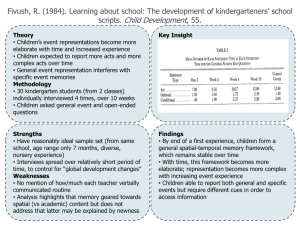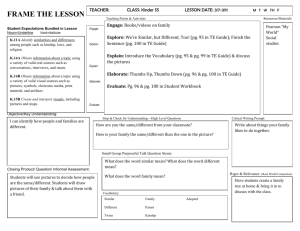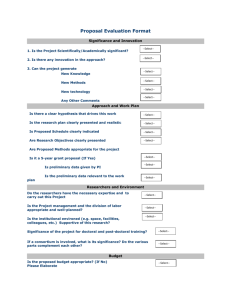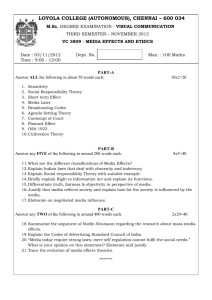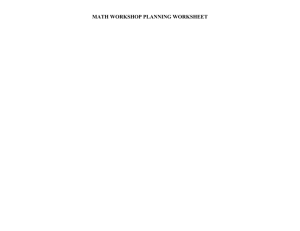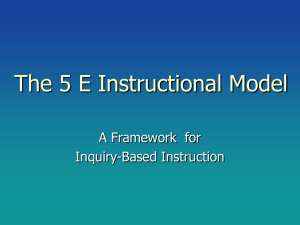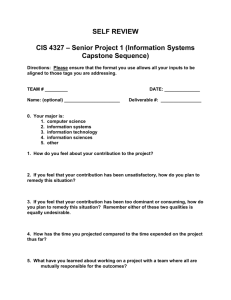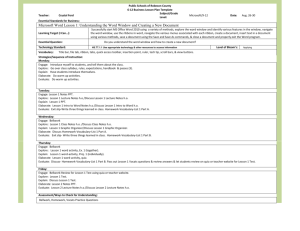History - common core subject in programmes for general studies
advertisement
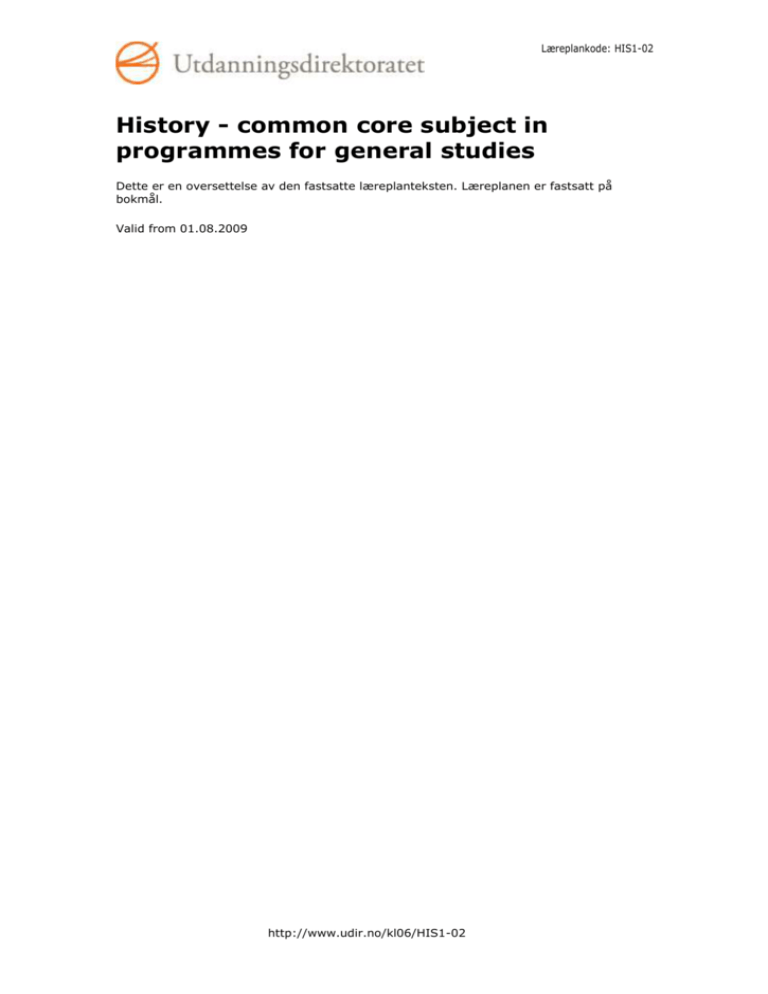
Læreplankode: HIS1-02 History - common core subject in programmes for general studies Dette er en oversettelse av den fastsatte læreplanteksten. Læreplanen er fastsatt på bokmål. Valid from 01.08.2009 http://www.udir.no/kl06/HIS1-02 Læreplan i historie - fellesfag i studieforberedende utdanningsprogram Læreplankode: HIS1-02 Purpose The history subject shall contribute to increasing understanding of relations between the past, present and future, and provide insight into the thoughts, lives and actions of people during different time epochs and cultures. Awareness of history provides the basis for reflection on one's own value choices. The subject shall provide insight into the diversity of living conditions of people in the past and increase the understanding that all communities represent values and attitudes that are the result of historical processes. It shall promote tolerance, mutual respect and understanding of human rights. The history subject shall provide insight into the importance of democracy in our society, and contribute to raising awareness of global challenges. The subject shall stimulate involvement and active participation in society by developing skills in critical, analytical and creative thinking. The history subject can have great impact on how pupils understand and perceive themselves and society, and on how each person creates his or her own identity and belongingness with others. The subject shall improve the pupil's knowledge of and insight into important events and lines of development in history. The subject shall promote the ability to process and assess historical material and other information. Historical insight can contribute to better understanding of contemporary affairs, and to understanding that each person is part of a historical process and part of creating history. Main subject areas The subject has been structured into main areas for which competence aims have been formulated. These main subject areas supplement each other and must be considered together. History has competence aims after Vg2 and Vg3 (the second and third years) in programmes for general studies. Overview of main subject areas: Year Main subject areas Vg2 Understanding of history and methods Society and people in a historical perspective Vg3 Understanding of history and methods Society and people in a historical perspective Understanding of history and methods The main subject area understanding of history and methods deals with how people think differently about the past, and how this is expressed in narratives and historical presentations. This main subject area deals with how historical knowledge is developed, understood and assessed. Emphasis is placed on being critical of sources, analysing how history is presented and assessing historical explanations. Another key aspect is how historians' choices of research topics change over time based on their point of view. Using history in today's society and examining how media influence perceptions of the past and the present are also included in this main subject area. Society and people in a historical perspective The main subject area society and people in a historical perspective comprises key historical phenomena and processes and draws lines between the past, the present and the future. Different perspectives on the past are in focus, including power and politics, Side 2 av 9 Læreplan i historie - fellesfag i studieforberedende utdanningsprogram Læreplankode: HIS1-02 social and economic conditions, culture and the way people were and thought. This main subject area attaches importance to continuity and change in the development of society and to humankind as actors in historical processes, both individually and in groups. Teaching hours Teaching hours are given in 60-minute units: PROGRAMMES FOR GENERAL STUDIES Vg2: 56 teaching hours Vg3: 113 teaching hours SUPPLEMENTARY STUDIES QUALIFYING FOR HIGHER EDUCATION - VOCATIONAL EDUCATION PROGRAMME Vg3: 140 teaching hours 113 teaching hours for pupils with Finnish as a second language Basic skills Basic skills are integrated in the competence aims where they contribute to development of the competence in the subject, while also being part of this competence. In the history subject basic skills are understood as follows: Being able to express oneself orally and in writing in history means presenting a history topic clearly and concisely and applying relevant terms in one's own argumentation, analysis and reasoning. It also means being able to reflect on the meaning of content in texts, pictures and film, and to elaborate on and compare points of view in historical sources and literature. Being able to read in history means developing one's vocabulary and general language skills by reading historical texts. This means reading with a critical mind and reflecting on how views on society influence a presentation. Key elements are reading and interpreting different types of historical material, with different origins and from different historical periods, and reading and interpreting pictures, film, historical maps and other graphic material, artefacts and written sources. Being able to do mathematics in history means interpreting and applying tables and graphic presentations in descriptions and analyses of issues, and using quantitative historical data in one's own presentations. Being able to use digital tools in history means developing awareness of being critical of sources when using the internet to find historical information. This means being able to search for and assess information from different websites and then use this in one's own presentations. Digital tools will be a natural aid for publication of one's own and joint work. Having digital skills also means being able to use digital communication and cooperation tools in interaction with others. Side 3 av 9 Læreplan i historie - fellesfag i studieforberedende utdanningsprogram Læreplankode: HIS1-02 Competence aims Competence aims after Vg2 in programmes for general studies Understanding of history and methods The aims of the studies are to enable pupils to find and assess historical material as sources and use this in historical presentations present a person from history and discuss how contemporary social frameworks influenced the actions of this person use digital tools to collect information from various media sources and assess the information with an eye to being critical of sources in own presentations identify different historical explanations and discuss how such explanations can characterise historical presentations explain why historians and others divide time into periods and discuss the criteria used for this Society and people in a historical perspective The aims of the studies are to enable pupils to explain how natural resources and technological developments have helped shape early society compare two or more societies from antiquity and discuss the importance of antiquity in modern politics, architecture or other art forms elaborate on a selection of key economic, social, political and cultural characteristics of developments in the middle ages present a topic from the middle ages by showing continuity or major shifts in one or more areas elaborate on social conditions and development of the state in Norway from around 700 to around 1500 and discuss possible influences from other cultures, societies and states elaborate on important features of Sami history and discuss Sami relations with states having Sami settlements up to around 1800 explain the driving forces behind European expansion overseas and discuss cultural encounters seen from different perspectives elaborate on the development of trade, commerce and industry in Norway from around 1500 to around 1800 and analyse the impact on social conditions during this period elaborate on the development of and changes in forms of government in Europe from the end of the middle ages up to the end of the 1700s elaborate on why population groups emigrate, and discuss and elaborate on the consequences of their encounters with other cultures Competence aims after Vg3 in programmes for general studies Understanding of history and methods The aims of the studies are to enable pupils to Side 4 av 9 Læreplan i historie - fellesfag i studieforberedende utdanningsprogram Læreplankode: HIS1-02 identify and assess different types of historical materials and origins as sources, and use them in his or her own historical presentations use digital tools to plan, carry out and present a problem-oriented study based on his or her own questions relating to historical material present a person from history and discuss and elaborate on how contemporary ideas and social conditions influenced the way this person thought and acted interpret and use historical data when working with history explore different brief historical presentations of one and the same event, and discuss the authors' choice of approach and research theses provide examples of controversial historical topics and discuss and elaborate on conflicting causal explanations of a historical event examine how his or her own ideas about the past have been shaped and discuss the factors that cause people to have different perceptions of the past discuss and elaborate on how history has been used and is used in political contexts provide examples and discuss and elaborate on how exhibitions, relics, anniversaries or celebrations of particular historical events are important for the present Society and people in a historical perspective The aims of the studies are to enable pupils to discuss and elaborate on how the ideas of the period of the Enlightenment influenced and were influenced by social revolutions in the 1700s and 1800s elaborate on the main features of the industrial revolution and examine its importance for the development of trade, commerce and industry and societal conditions in Norway elaborate on the development of democracy in Norway from the 1800s and up to 1945 and analyse the driving forces behind this development present key features of colonialism and the situation in a non-European area in the 1800s seen from different perspectives discuss and elaborate on how the national state has created a sense of national and cultural belonging, but also conflicts and suppression assess the importance of different ideologies for people, political movements and the development of the state in the 1900s discuss and elaborate on the background of the two world wars and discuss and elaborate on the impact these wars had on the Nordic countries and the international community discuss and elaborate on some economic, social, political and cultural characteristics of post-war development in Norway discuss and elaborate on the policy conducted by the Norwegian national state in relation to indigenous peoples, national and ethnic minorities in the 1800s and 1900s, and discuss some consequences of this policy examine two or more international conflicts after 1945, and assess these based on different perspectives find examples of events that have shaped the history of a non-European country after 1900, and reflect on how the country might have developed if these events had not taken place examine the background for an on-going conflict, and discuss and elaborate on reactions in the international society provide examples of how different expressions in music, architecture or pictorial art may be considered in relation to developments in other societal areas discuss and elaborate on how working life and work division between the genders have changed in Norway from the 1800s up to today discuss and elaborate on the development in population in a local community over a relatively long period of time and discuss which factors have had importance for the life situation of the inhabitants Side 5 av 9 Læreplan i historie - fellesfag i studieforberedende utdanningsprogram Læreplankode: HIS1-02 competence aims after the supplementary studies qualifying for higher education – vocational education programme Understanding of history and methods The aims of the studies are to enable pupils to explain why historians and others divide time into periods and discuss the criteria used for this find and assess different types of historical materials and origins as sources, and usethem in his or her own historical presentations use digital tools to plan, carry out and present a problem-oriented study based on his or her own questions relating to historical material present a person from history and discuss how contemporary social frameworks influenced the actions of this person interpret and use historical data when working with history explore different brief historical presentations of one and the same event, and discuss the authors' choice of approach and research theses discuss and elaborate on how history has been used and is used in political contexts examine how his or her own ideas about the past have been shaped and discuss the factors that cause people to have different perceptions of the past provide examples and discuss and elaborate on how exhibitions, relics, anniversaries or celebrations of particular historical events are important for the present Society and people in a historical perspective The aims of the studies are to enable pupils to explain how natural resources and technological developments have helped shape early society compare two or more societies from antiquity and discuss the importance of antiquity in modern politics, architecture or other art forms present a topic from the middle ages by showing continuity or major shifts in one or more areas elaborate on social conditions and development of the state in Norway from around 700 to around 1500 and discuss possible influences from other cultures, societies and states elaborate on important features of Sami history and discuss Sami relations with states having Sami settlements up to around 1800 discuss and elaborate on how the ideas of the period of the Enlightenment influenced and were influenced by social revolutions in the 1700s and 1800s elaborate on the development of trade, commerce and industry in Norway from around 1500 to around 1800 and analyse the impact on social conditions during this period elaborate on the main features of the industrial revolution and examine its importance for the development of trade, commerce and industry and societal conditions in Norway elaborate on the development of democracy in Norway from the 1800s and up to 1945 and analyse the driving forces behind this development present key features of colonialism and the situation in a non-European area in the 1800s seen from different perspectives discuss and elaborate on how the national state has created a sense of national and cultural belonging, but also conflicts and suppression assess the importance of different ideologies for people, political movements and the development of the state in the 1900s discuss and elaborate on the background of the two world wars and discuss and elaborate on the impact these wars had on the Nordic countries and the international community Side 6 av 9 Læreplan i historie - fellesfag i studieforberedende utdanningsprogram Læreplankode: HIS1-02 discuss and elaborate on some economic, social, political and cultural characteristics of post-war development in Norway discuss and elaborate on the policy conducted by the Norwegian national state in relation to indigenous peoples, national and ethnic minorities in the 1800s and 1900s, and discuss some consequences of this policy examine one or more international conflicts after 1945, and assess these based on different perspectives find examples of events that have shaped the history of a non-European country after 1900, and reflect on how the country might have developed if these events had not taken place examine the background for an on-going conflict, and discuss and elaborate on reactions in the international society provide examples of how different expressions in music, architecture or pictorial art may be considered in relation to developments in other societal areas competence aims after the supplementary studies qualifying for higher education – vocational education programme, pupils with Finnish as a second language Understanding of history and methods The aims of the studies are to enable pupils to explain why historians and others divide time into periods and discuss the criteria used for this find and assess different types of historical materials and origins as sources, and usethem in his or her own historical presentations use digital tools to plan, carry out and present a problem-oriented study based on his or her own questions relating to historical material present a person from history and discuss how contemporary social frameworks influenced the actions of this person interpret and use historical data when working with history explore different brief historical presentations of one and the same event, and discuss the authors' choice of approach and research theses discuss and elaborate on how history has been used and is used in political contexts examine how his or her own ideas about the past have been shaped and discuss the factors that cause people to have different perceptions of the past provide examples and discuss and elaborate on how exhibitions, relics, anniversaries or celebrations of particular historical events are important for the present Society and people in a historical perspective The aims of the studies are to enable pupils to explore one or more societies from antiquity and discuss the importance of antiquity in present time present a topic from the middle ages by showing continuity or major shifts in one or more areas elaborate on social conditions and development of the state in Norway from around 700 to around 1500 and discuss possible influences from other cultures, societies and states elaborate on important features of Sami history and discuss Sami relations with states having Sami settlements up to around 1800 discuss and elaborate on how the ideas of the period of the Enlightenment influenced and were influenced by social revolutions in the 1700s and 1800s elaborate on the development of trade, commerce and industry in Norway from around 1500 to around 1800 and analyse the impact on social conditions during this period Side 7 av 9 Læreplan i historie - fellesfag i studieforberedende utdanningsprogram Læreplankode: HIS1-02 elaborate on the main features of the industrial revolution and examine its importance for the development of trade, commerce and industry and societal conditions in Norway elaborate on the development of democracy in Norway from the 1800s and up to 1945 and analyse the driving forces behind this development present key features of colonialism and the situation in a non-European area in the 1800s seen from different perspectives discuss and elaborate on how the national state has created a sense of national and cultural belonging, but also conflicts and suppression assess the importance of different ideologies for people, political movements and the development of the state in the 1900s discuss and elaborate on the background of the two world wars and discuss and elaborate on the impact these wars had on the Nordic countries and the international community discuss and elaborate on some economic, social, political and cultural characteristics of post-war development in Norway discuss and elaborate on the policy conducted by the Norwegian national state in relation to indigenous peoples, national and ethnic minorities in the 1800s and 1900s, and discuss some consequences of this policy examine one or more international conflicts after 1945, and assess these based on different perspectives find examples of events that have shaped the history of a non-European country after 1900, and reflect on how the country might have developed if these events had not taken place Assessment Provisions for final assessment: Overall achievement grades Year Provision Vg3 programmes for general studies Vg3 supplementary studies qualifying for higher education – vocational education programme The pupil shall have one overall achievement grade. When the subject is taught over a number of years, only the overall achievement grade from the highest level will be given on the competence certificate or school leaving certificate. Examinations for pupils Year Provision Vg3 programmes for general studies Vg3 supplementary studies qualifying for higher education – vocational education programme The pupil may be selected for an oral examination. The examination is prepared and graded locally. The examination covers the entire subject. Examinations for external candidates Year Provision The external candidate must sit for an oral examination. The examination is prepared and graded locally. The examination covers the entire Vg3 supplementary studies qualifying subject. Vg3 programmes for general studies Side 8 av 9 Læreplan i historie - fellesfag i studieforberedende utdanningsprogram Læreplankode: HIS1-02 for higher education – vocational education programme The general provisions on assessment have been laid down in the Regulations relating to the Norwegian Education Act. Side 9 av 9
